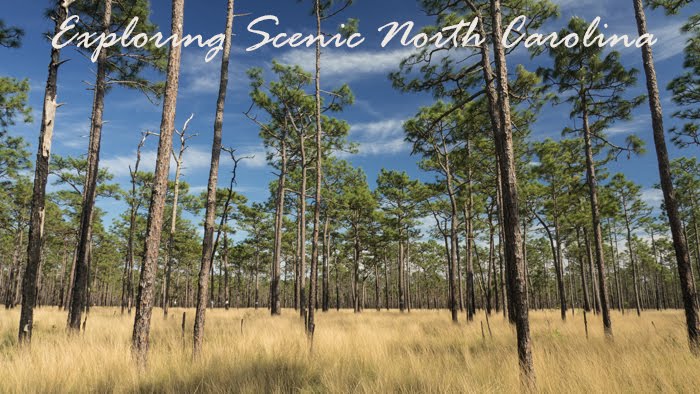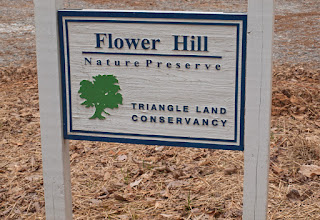
During
the dreary days of winter, most native wildflowers are fast asleep
until spring arrives. There is not much to see flower-wise this
time of year, but it is a good time go out in search of evergreen
and wintergreen plants. A couple weeks I visited a
favorite nature preserve, FlowerHill
to
photograph some
of these botanical jewels.
So
what are evergreens and
wintergreens? While most native
herbs
died back once the growing season ends, evergreens
have leaves that are persist
all year long. Wintergreens
are plants that have leaves that are alive during the winter
months, and disappear in the
spring or summer. At
Flower Hill,
there are several examples of both.
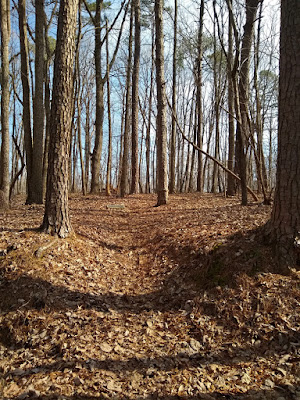 |
| Trail head view |
My main goal was to photograph the wintergreen orchid Tipularia discolor or Cranefly Orchid. This orchid is more recognizable by its leaves than the flowers. The leaf variation in this species is quite interesting. There is one
place at Flower Hill where 4 different color variations occur all within
a few feet of each other.
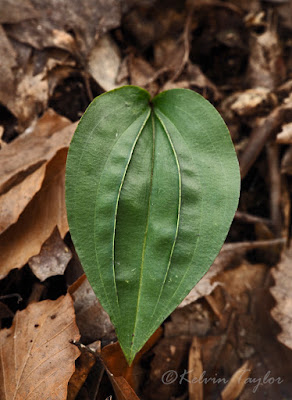 |
Solid green leaf
|
|
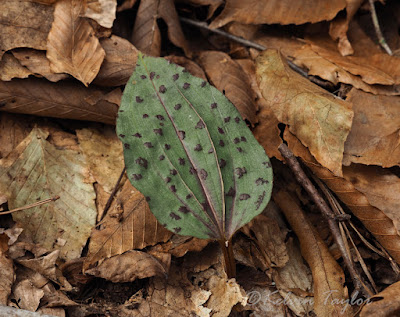 |
Leaf dark purple spots
|
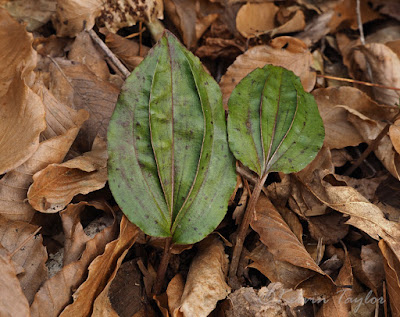 |
Yellowish green leaf
|
|
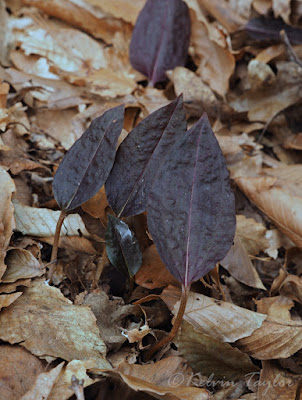 |
Dark reddish purple leaves
|
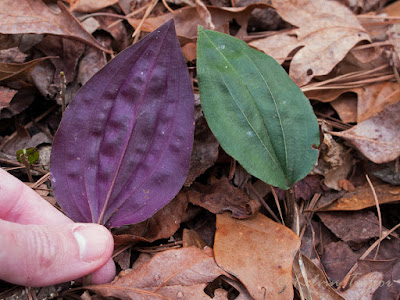 |
| Purple underside |
|
T. discolor is the most common native orchid species in North Carolina occurring from the mountains to the coast and blooms in mid-summer.
After spending time admiring these wonderful leaves, I continued down the trail to a spot where I found another species of orchid, Goodyera pubescens or Downy Rattlesnake Plantain, an evergreen plant with attractive foliage. The intricate white lines against the glossy, dark green leaves
resemble the foliage of tropical jewel orchids. G. pubescens blooms with white flowers in mid-summer.
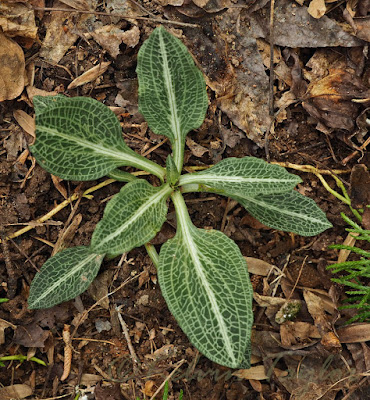 |
Goodyera pubescens
|
|
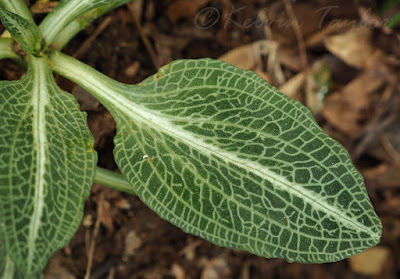 |
Close-up of the leaf design
|
Another evergreen that is ubiquitous in the mountains and extends to a much lesser extent into the Piedmont is Galax urceolata or Galax. At Flower Hill it grows near Rhododendron catawbiense or Catawba Rhododendron, but more on that plant later. Galax blooms with a spike of small, showy white flowers during the summer.
 |
Galax urceolata
|
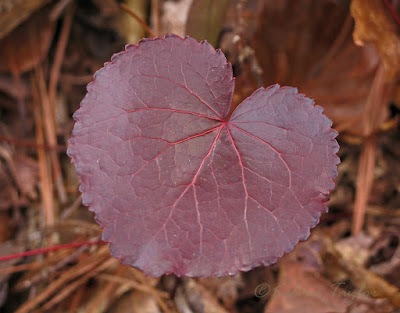 |
| A red-wine Galax leaf during it's winter coloration |
Along the trail I found three other evergreens: Epigaea repens or Trailing Arbutus, Chimaphila maculata or Striped Wintergreen and Hexastylis sp. or Wild Ginger. The Trailing Arbutus was in bud. It blooms with cute white to sometimes pink flowers in late winter and early spring.
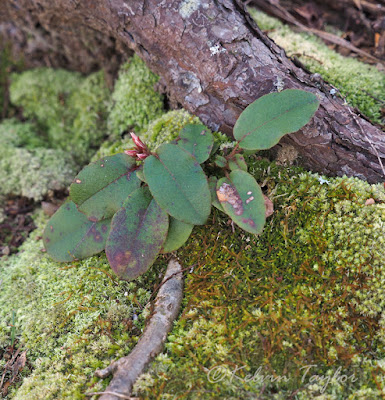 |
| Epigaea repens in bud at the base of a pine tree |
Striped wintergreen, also known as Pipsissewa, has attractive evergreen foliage and grows as a single plant or small groups in xeric, acidic soils. It blooms late spring and summer with nodding, waxy, creamy white flowers borne on a stalk above the top whorled of leaves.
 |
Chimaphila maculata
| |
Growing on slopes and along the trail is this evergreen plant commonly called Wild Ginger or Little Heartleaf depending on which species of Hexastylis. Absent the flowers(too early for it to bloom) I'm not sure species. Positive ID can't always be via the foliage as the leaf variegation(or lack of it) varies within the same species. So a return trip when flowering will be needed for species confirmation .
Hexastylis blooms in the spring with flowers at ground level. Most people would never notice them as they blooms are often covered by leaf litter.
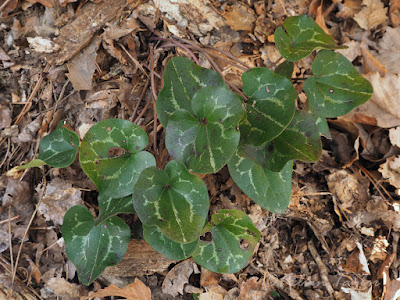 |
Hexastylis sp.
|
At the first ravine crossing on the trail,
I took a detour and
climbed
down into the ravine to the
banks of Moccasin
Creek. This wasn't easy as some steep banks and fallen trees made the task a challenge in spots.
Here on the banks of Moccasin
Creek I spotted mosses growing in the shady, moist, cool
environment covering logs of fallen trees, rocks and on the moist ground. These mini evergreen plants are bryophytes, belonging to the division Bryophyta. They don’t have flowers or seeds, but they do produce spores, as do
fungi. Mosses don’t have roots; they absorb water and nutrients
through their leaves. There are approximately 440 species of mosses that occur in North Carolina and they do an important job(along with fungi) in breaking down organic
matter into nutrients.
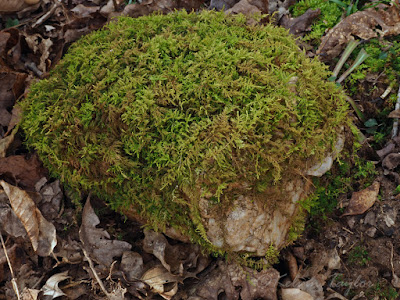 |
Fern moss(Thuidium delicatulum) covering a rock
|
 |
| Closeup of fern moss(Thuidium delicatulum) |
A fallen tree over time in a forest will be covered with a host of organisms including mosses. The wood from fallen trees, will over a period of years return back to which it came. In the photo below are at least two species of mosses, I'm thinking belong to the genera Fissidens and Semtophyllum.
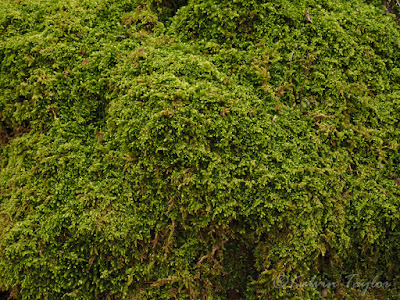 |
| Combination of mosses on a fallen trunk |
After photographing the mosses I headed back up the steep ravine. It was slow going as the fallen trees made for some tough obstacles in places. This actually turned out to be a good thing. As I made my way carefully up the ravine, I spotted a small clump of erect clubmoss at the base of a tree. Of course I had to get a closer look. It turned out to be a species that is uncommon to rare in the Piedmont.
Shining Clubmoss or Huperzia lucidula, a species I had not seen before outside the mountains of NC. It grows in moist forests and ravines and its uncommon to rare in the part of the state.
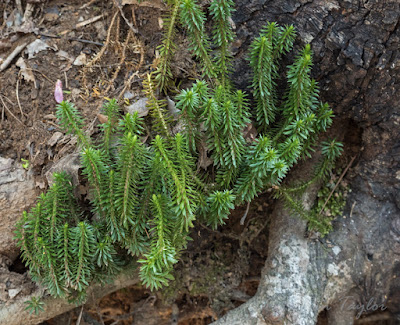 |
| Huperzia lucidula |
After climbing out of the ravine I returned to the trail and continued on. One notable tree at the preserve is a large Longleaf Pine or Pinus palustris. I don't know the age of the tree, but it is the largest one I ever seen at least in this part of the state.
 |
| a large Pinus palustris |
|
|
|
|
|
|
No field report would be complete without mention of what Flower Hill special. Along the banks of Moccasin Creek is the prize evergreen of this nature preserve Catawba Rhododendron or Rhododendron catawbiense, a natural population some 200+ miles east of
its native range in the Blue Ridge Mountains of North Carolina.
It was North Carolina naturalist B.W. Wells on a visit in the 1930s that brought this geographic anomaly on the Johnston/Nash county line to national attention. Dr. Wells identified it as a disjunct
mountain community that survived the retreat of the
last ice age 10,000 years ago. It was deemed a freak of
nature because of this species being so far from where is normally
grows. The topography of the land is unique to the area here on the
boarder of the Piedmont and Coastal Plain. The microclimate of the
north west facing slopes provided a ideal place for this native
evergreen shrub to hang on.
 |
| Catawba Rhododendron in bloom(April) |
Blooming starts in mid-April and peaks around early May. Flowers vary from light to deep pink, and a small population on the high banks above Moccasin Creek have white
flowers.
After enjoying the flora I returned back to my vehicle. Before leaving I noticed a several feet inside the woods at the parking lot a dense mat of green. I had to go see what it was. What I found was another species of clubmoss, Running Cedar or Diphasiastrum digitatum. (Formerly belonged to the genus Lycopodium).
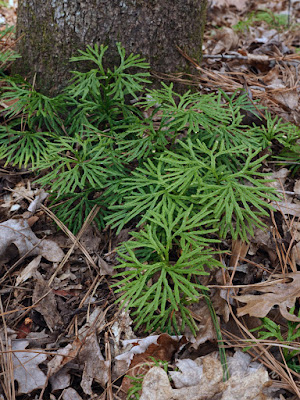 |
| Diphasiastrum digitatum |
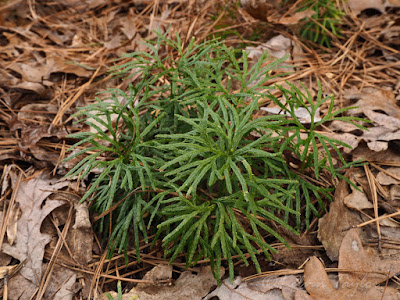 |
| Diphasiastrum digitatum |
 |
| Large area covered with Running Cedar |
Running Cedar is an evergreen subshrub that spreads by underground
runners and also reproduces via spores. The leaves form flattened fans, somewhat reminiscent of conifers such as arborvitae. In the summer reproductive structures, called strobili,
appear atop the plants. These strobili bear sporangia that contain the spores. Occurs in dry to mesic acid forests and openings, especially in
disturbed sites, such as successional pine forests. Running Cedar is common in the
mountains and Piedmont, uncommon in Coastal Plain.
Visit Flower Hill anytime of the year and there is always something to see. Spring is when the flush of flowers are seen, but in autumn and winter there are other botanical treasures to be found.
See you next time for another adventure in Scenic North Carolina.
Kt
Flower Hill Nature Preserve is located in Johnston County North Carolina and is owned by the Triangle Land Conservancy. Access to the parking lot is from Flower Hill Road. For more information check out the website
www.triangleland.org/explore/nature-preserves/flower-hill-nature-preserve
Light is the first element of creation





